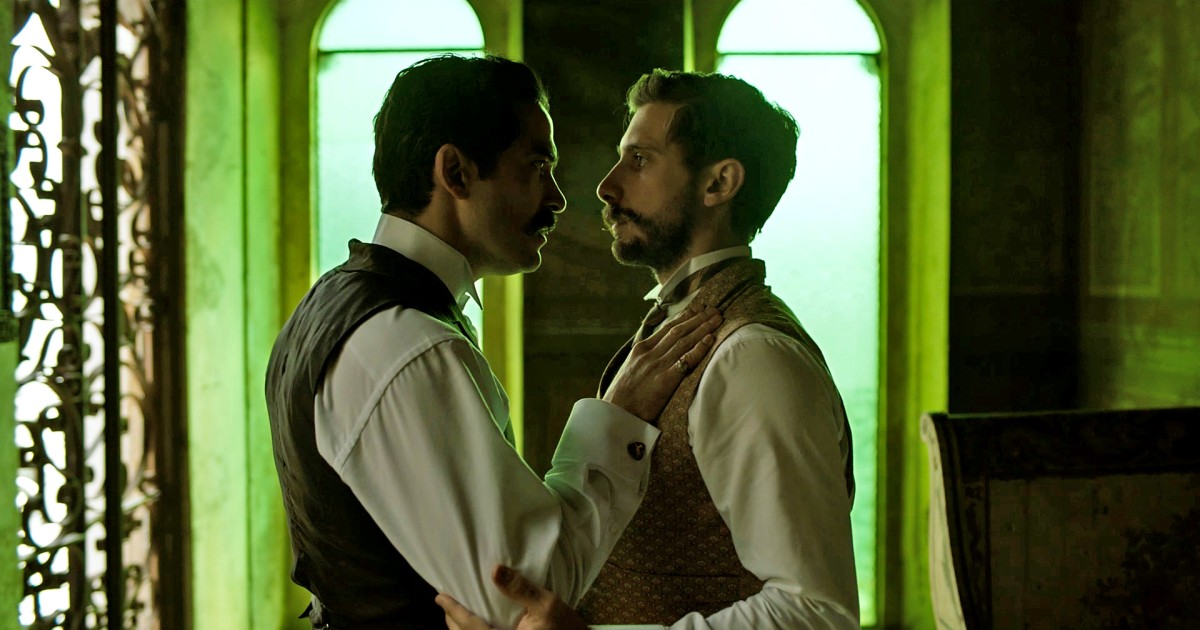
More than 120 years after an infamous police raid rocked Mexican high society, Netflix has released “Dance of the Forty One,” a fictionalized retelling of a major political scandal that has had a lasting impact on the country’s culture and depictions of the LGBTQ community.
Directed by David Pablos and penned by Monika Revilla, the film — which premiered in Mexican theaters in November and is now streaming on Netflix — follows the double life of Ignacio de la Torre y Mier (Alfonso Herrera), a businessman, politician and son-in-law of President Porfirio Díaz (Fernando Becerril). As his wife, Amada (Mabel Cadena), begins to grow suspicious of his whereabouts, Ignacio begins to develop a fatal attraction to a man named Evaristo Rivas (Emiliano Zurita), whom he introduces to his clandestine club of homosexual men.
The film’s title — its original in Spanish is “El Baile de los 41” — refers to the night of Nov. 17, 1901, when police raided a private home in Mexico City. The official report was that they found 41 prominent men dancing together — half of whom were dressed as women. But a scandal ensued when initial reports placed a 42nd man in attendance, and the story spread that it was de la Torre, the president’s son-in-law, marking the first time homosexuality was openly discussed in the Mexican media.
Growing up in Mexico City, lead actor Alfonso Herrera said it was customary for the people around him to avoid the number 41, but it wasn’t until he was much older that he came to understand the negative “connotation and meaning that this number had for the Mexican society.”
Herrera, 37, who is best known internationally for his work in “The Exorcist” and “Sense8,” said he immediately jumped at the chance to work with Pablos, who directed the award-winning 2015 movie “Las Elegidas.”
“You need to go to the past in order to understand who you are as a person or who you are as a society,” Herrera told NBC News in an exclusive video interview last week. “What would have happened if Ignacio was not discovered as a gay man? He would have been one of the important Mexican figures from our history, but he was taken away from that because he was gay.”
Herrera said he couldn’t pass up the opportunity to return to a critical — but often ridiculed and caricatured — part of his home country’s history.
Before beginning production on the film in late 2019, the actor sought to learn as much as he could about the scandal, including delving into the enigmatic life of de la Torre.
“I was literally searching for bits and pieces here and there,” Herrera said. “There’s a book called ‘El Exilio,’ written by Carlos Tello Díaz, who was a family member from the lineage of Porfirio Díaz, and that specific book was very important — at least for me and David — to understand a little more about Ignacio.”
In the opening scene of the film, de la Torre arrives late to his own engagement party. That’s based, Herrera said, on a tense, real-life exchange between the young man and his future father-in-law, the Mexican president.
“Ignacio was an alcoholic and he was one of the first guys in Latin America who owned a motor car at that time. He arrived late to the house, all of the family was at the table waiting for him, and Porfirio Díaz said, ‘Ignacio, cars run with gasoline, not with cognac,’” Herrera said, adding he still has that scene “very present in my mind.”
‘He loved power’
As Herrera worked to better understand the mysterious man he would later embody, he found himself wondering the same thing on more than one occasion: Why didn’t Ignacio de la Torre use his economic power to leave Mexico and build a new life for himself? The answer, it seems, was quite simple.
“He loved power; he loved the position where he was. There’s a phrase in Mexico, ‘Más vale ser cabeza de ratón que cola de león,’ it’s better to be the head of a mouse than the tail of a lion,” Herrera said about de la Torre. “That was a very important answer for me to understand the character and to battle the scenes.”
Herrera said it was important to portray de la Torre as the important businessman he was but at the same time show this “need that he had, which is represented by Evaristo.”
In actor Emiliano Zurita, Herrera said he found a generous scene partner with whom he worked for nearly two months to build the intimate relationship the men share on screen.
“I admire Emiliano a lot because he’s 10 years younger than me, and he was very brave to accept this role, specifically in the society that we live in,” he said. “This bond we created is not just me knowing Emiliano; it’s literally understanding him, feeling comfortable and connected with him as a person.”
“We wanted to honor these men,” Herrera said, adding that some of the men at the party were sent to labor camps in Yucatán, where some of them died.
“We wanted to portray these men as men who wanted to be free, who wanted to be happy, and I think that David did this in a very accurate way — in a very safe way — where they could be themselves,” he said.
‘Society is the real villain here’
While this film underlines the historical mistreatment of the LGBTQ community, it also sheds light on the strict gender roles that left men like de la Torre feeling stifled in class-based and patriarchal societies, where women were also mistreated and “used as a form of currency.”
“I think the main villain is not a specific character, but it’s the lines and the regulations that society puts [on people]. Society is the real villain here,” Herrera said, citing the example of Díaz appointing de la Torre to Congress in exchange for making his daughter happy.
“I think that this film talks about what happens if you really want to be yourself and perceptions of society,” he said. “This story talks about people wanting to be free, wanting to not feel attached or feel that they need to behave in a certain way in order to be accepted.”
More than a century later, Herrera feels that “some steps have been made” in different areas of the country, but, in his words, “many things are still the same, and that is not a secret for anyone.”
“I remember David and I were shooting a scene in the MUNAL to portray el Castillo de Chapultepec where Porfirio Díaz lived, and there were 200 extras,” the veteran actor recalled. “We stood and we watched the people there. We looked at each other and we said, ‘You know, our society hasn’t changed that much. If you change the art, if you change the clothes from the people, it’s exactly the same — how our society behaves, the norms that our societies have.’ And that’s why I say it’s important to go to the past to understand who we are.”
As someone who is consistently in the process of “re-educating myself” — a value he and his wife, Diana Vázquez, would like to pass on to their young children — Herrera understands the potential controversy surrounding his decision to play a gay character. But in the complicated debate of which actors should be allowed to play which roles, he feels that directors should use their own discretion in the casting process because “they know the story that they want to tell.”
It is ultimately his hope that, with the increased reach of Mexican films on major streaming platforms like Netflix, there will be an increase in diverse and respectful representation of more LGBTQ stories — and Latino ones, as well.
“In order for us to have better societies with more compassion and empathy, we need to be respectful, and we need to respect minorities,” Herrera said.
“Talking about Latinos, it’s very complicated, and I hope we can have some more flexibility about who we are,” he said. “I hope that societies are going to be more curious about who we really are because when that happens, maybe the stories are going to change, maybe the roles are going to change and maybe we’re going to have a different perception.”
As Herrera begins production on the fourth and final season of Netflix’s “Ozark” — he’s one of the new characters — he’s eager to continue learning from industry professionals who work both behind and in front of the camera, while also continuing to challenge Latino perceptions and stereotypes like he did as a Mexican priest in “The Exorcist.”
“When I first open a script and I say, ‘I don’t know how I’m going to attack this,’ that’s my first yes. I really want to pull my sleeves up, and say, ‘OK, I’m going to dig in. This is going to be a hard one,’” he said. “I think being open to learning is what makes me feel hungry to tell more stories, to seek stories that can tell something, that can say something, and characters that are, in a certain way, complicated.”
Follow NBC Latino on Facebook, Twitter and Instagram.
Source: | This article originally belongs to Nbcnews.com










